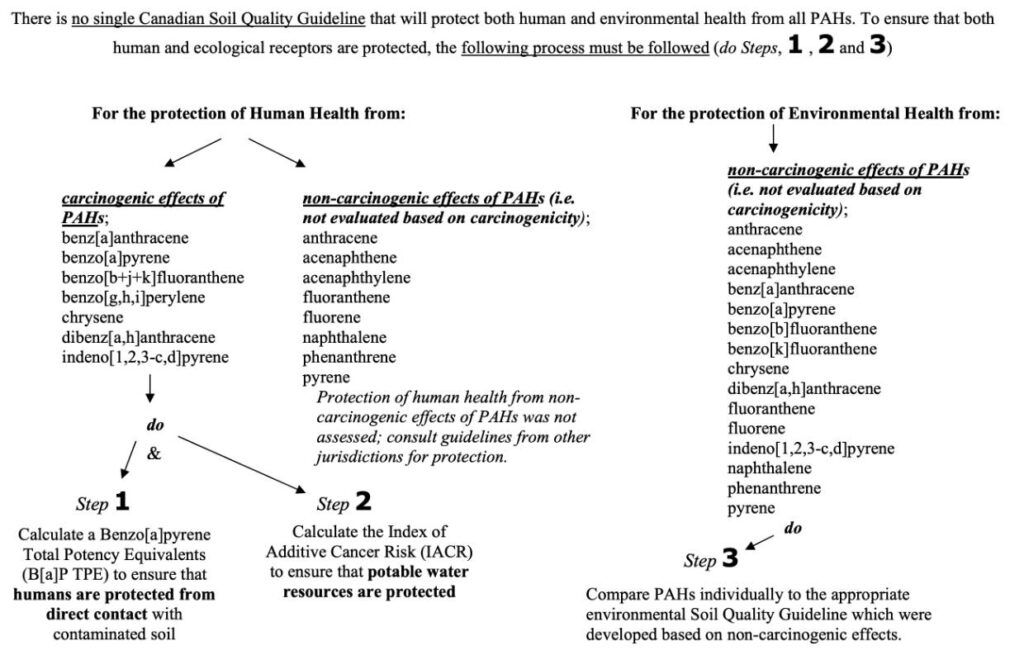The document provides detailed guidelines on Canadian Soil Quality for protecting environmental and human health, focusing on Polycyclic Aromatic Hydrocarbons (PAHs). It revises the 2008 guidelines, incorporating improvements in the understanding and implementation of PAH soil quality guidelines, superseding those from 1997.

The key points include:
- PAH Sources and Nature: PAH contamination is widespread in Canada due to its sources, including petroleum hydrocarbon or coal-derived products and combustion processes. PAHs consist of complex hydrocarbons with two or more fused benzenoid rings, occurring naturally and through anthropogenic activities. Their solubility in water decreases with an increase in molecular weight and several rings, affecting their behaviour in the environment.
- Human and Environmental Health Concerns: PAHs are given significant attention due to their potential as carcinogens. The guidelines address management gaps for PAH-contaminated soils, focusing on human health risks from exposure to carcinogenic PAHs and the ecological effects of unsubstituted PAHs. They list specific PAHs known or suspected to act as carcinogens, including Benzo [a]pyrene, benz[a]anthracene, and several others.
- Implementation of Guidelines: The document provides a systematic approach for applying the soil quality guidelines at contaminated sites, considering PAHs’ non-carcinogenic and carcinogenic effects. It includes calculating Benzo [a]pyrene Total Potency Equivalents (B[a]P TPE) and the Index of Additive Cancer Risk (IACR) to protect human health and potable water resources, respectively.
- Soil Quality Guidelines for Carcinogenic and Other PAHs: Tables present soil quality guidelines based on land use types (agricultural, residential/parkland, commercial, industrial) for carcinogenic effects (direct contact and protection of potable water) and non-carcinogenic effects of PAHs.
- Environmental Behavior and Effects: The guidelines discuss the fate of PAHs in the soil, including their hydrophobic nature, adsorption, and biodegradation processes. They also cover the effects on biota, including microbial degradation, toxicity to plants and terrestrial invertebrates, and potential impacts on livestock and wildlife. The guidelines outline modes of toxicity and the variability in bioavailability and toxicity across different soil types and organisms.
This summary emphasizes Canada’s comprehensive approach to addressing PAH contamination in soils. It covers the complexities of PAH properties, environmental and health risks, and guidelines for managing contaminated sites effectively.
You can read the full document at https://support.esdat.net/Environmental%20Standards/Canada/CCME/PAH_2010.pdf

Comprehensive Overview of Global Environmental Standards on ESdat
The ESdat’s Environmental Standards page provides a comprehensive overview of a pre-compiled library of regulatory guidelines for environmental standards. It covers various regional guidelines, including the United States, Canada, Australia, New Zealand, and the United Kingdom.
The ESdat platform adds custom environmental standards as needed and offers real-time alerts for guideline exceedances. The guidelines cover various environmental parameters, such as pH, hardness, and depth & matrix dependencies. ESdat’s library is designed to help users compare their laboratory and field results against a comprehensive set of regulatory guidelines through tables, maps, graphs, and more, thus facilitating compliance with environmental standards across different jurisdictions.
Related Articles to Canadian Soil Quality Guidelines for PAHs
What are Canada’s environmental guidelines and policies?
What is Environmental Remediation?







[…] Canadian Soil Quality Guidelines for PAHs: Protecting Environmental and Human Health […]